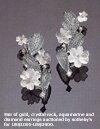 The word aquamarine symbolizes the deep blue waters of the sea. Aqua means ‘water’ and marine means ‘of the sea’. The name obviously comes from the fact that all aquamarines are blue in color. The gem owes its name and popularity to the unique color that it has. This blue gemstone is the birthstone for the people born in the month of March and hence called as the March Birthstone.
The word aquamarine symbolizes the deep blue waters of the sea. Aqua means ‘water’ and marine means ‘of the sea’. The name obviously comes from the fact that all aquamarines are blue in color. The gem owes its name and popularity to the unique color that it has. This blue gemstone is the birthstone for the people born in the month of March and hence called as the March Birthstone.
In India, the gem is know by it trade name ‘Beruj’. It is the birth stone for the month of march and a quality is sought after gem.
 The aquamarine rough was first mined in 1811 in Brazil. However, history has it that it has been used in jewelry much before this time. One of the first documented proofs of the use of aquamarine gemstones exists between 480 and 300 BC. This gem was used by the Greeks to make aquamarine jewelry. In the middle ages, people believed that this gem stone could magical overcome the effects of poison.
The aquamarine rough was first mined in 1811 in Brazil. However, history has it that it has been used in jewelry much before this time. One of the first documented proofs of the use of aquamarine gemstones exists between 480 and 300 BC. This gem was used by the Greeks to make aquamarine jewelry. In the middle ages, people believed that this gem stone could magical overcome the effects of poison.
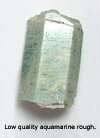 Pirates and sailors used small opaque and translucent aquamarine rocks and (some times good quality aquamarine crystals too) as amulets and believed that it would protect them from the raging sea and ensure a safe return. In some parts of the world the aquamarine birthstone is considered to be a symbol of eternal youth, joy and happiness.
Pirates and sailors used small opaque and translucent aquamarine rocks and (some times good quality aquamarine crystals too) as amulets and believed that it would protect them from the raging sea and ensure a safe return. In some parts of the world the aquamarine birthstone is considered to be a symbol of eternal youth, joy and happiness.
The chemical formula for an aquamarine gem stone is beryllium aluminum silicate (3BeO Al2 O3 6 SiO2). Its specific gravity is 2.71 and refractive index ranges from 1.574 to 1.580. Its hardness on Mohs scale is between 7.5 and 8. It has a vitreous polish luster.
Aquamarine gemstone is a transparent variety of the mineral group beryl.
Aquamarine Color
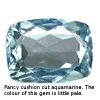 While all the aquamarine gemstones are a lovely blue color, they can be found in colors that are bluish-green, blue-green, light greenish-blue, greenish blue, light blue natural and beautiful light blue. The trace element in this case is iron. Regardless of its luster, even the most well polished deepest blue genuine aquamarine gemstone does not match up to the royal blue excellent brilliance of the sapphire gemstone.
While all the aquamarine gemstones are a lovely blue color, they can be found in colors that are bluish-green, blue-green, light greenish-blue, greenish blue, light blue natural and beautiful light blue. The trace element in this case is iron. Regardless of its luster, even the most well polished deepest blue genuine aquamarine gemstone does not match up to the royal blue excellent brilliance of the sapphire gemstone.
Cut
 Since the supply of genuine natural aquamarine gemstone is large, the rough material with heavy inclusions are often used in carving. The good clear transparent crystals are faceted into various simple shapes like oval, round and complicated ones like square princess, heart shaped, trillion cut, pear cut etc. Gems with different types of fancy cut and cushion cut are commonly used in fashion jewelry like rings, bracelets, earrings, pendants etc.
Since the supply of genuine natural aquamarine gemstone is large, the rough material with heavy inclusions are often used in carving. The good clear transparent crystals are faceted into various simple shapes like oval, round and complicated ones like square princess, heart shaped, trillion cut, pear cut etc. Gems with different types of fancy cut and cushion cut are commonly used in fashion jewelry like rings, bracelets, earrings, pendants etc.
Carat
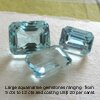 Not only these gemstones are available in abundance but also the sizes that they are available are in large. The mines of Minas Gerais, Brazil produced the largest aquamarine till date in 1990. It weighed 110 Kilograms and was 19 inches long with a diameter of 15 inches.
Not only these gemstones are available in abundance but also the sizes that they are available are in large. The mines of Minas Gerais, Brazil produced the largest aquamarine till date in 1990. It weighed 110 Kilograms and was 19 inches long with a diameter of 15 inches.
Clarity
 Though aquamarine gemstones are not completely flawless, they do not have many natural inclusions. The trasparent rough crystals are usually eye clean. And those that are there are mainly faint natural inclusions. The most common eye visible inclusions are raindrop like needles which can be clearly seen under magnification.
Though aquamarine gemstones are not completely flawless, they do not have many natural inclusions. The trasparent rough crystals are usually eye clean. And those that are there are mainly faint natural inclusions. The most common eye visible inclusions are raindrop like needles which can be clearly seen under magnification.
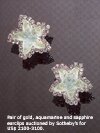 Today aquamarine gemstone is not as expensive as it used to be earlier. Although it is still one of the popular gemstones used in jewelry, its wide availability has resulted in a decline in prices. The main factor that affects the price of this gem is the color. Secondary factors that affect price are its carat size and clarity. The cut of the gemstone is not an important factor when it comes to deciding the price since it is readily available in various cuts.
Today aquamarine gemstone is not as expensive as it used to be earlier. Although it is still one of the popular gemstones used in jewelry, its wide availability has resulted in a decline in prices. The main factor that affects the price of this gem is the color. Secondary factors that affect price are its carat size and clarity. The cut of the gemstone is not an important factor when it comes to deciding the price since it is readily available in various cuts.
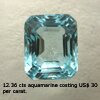 A fine quality natural aquamarine gemstone with good luster that weighs a carat would cost somewhere around $25. These gems are usually found in huge sizes so the basic rule of gemstones pricing, ‘the bigger the stone the more the per carat rate’ does not apply here. A good quality aquamarine gem which is 15 carats is likely to cost $ 35 or less per carat and the weight of the stone does not really matter much here. Light and pale aquamarine rough with visible yellow or white tint and which are translucent are cheaply available from $1 per carat onwards.
A fine quality natural aquamarine gemstone with good luster that weighs a carat would cost somewhere around $25. These gems are usually found in huge sizes so the basic rule of gemstones pricing, ‘the bigger the stone the more the per carat rate’ does not apply here. A good quality aquamarine gem which is 15 carats is likely to cost $ 35 or less per carat and the weight of the stone does not really matter much here. Light and pale aquamarine rough with visible yellow or white tint and which are translucent are cheaply available from $1 per carat onwards.
 Most of largest rough untreated (unheated) crystals of fine aquamarine in the world market today are from Brazil. The Brazilians know best how this gem is mined and since the gemstone was first mined in the country in 1811, Brazil has been consistently producing fine natural aquamarine gemstones.
Most of largest rough untreated (unheated) crystals of fine aquamarine in the world market today are from Brazil. The Brazilians know best how this gem is mined and since the gemstone was first mined in the country in 1811, Brazil has been consistently producing fine natural aquamarine gemstones.
Other countries where aquamarine crystal is mined are India, Pakistan, Mozambique, Nigeria, China, Madagascar, Namibia, Zambia, Zimbabwe, Norway, North Ireland, Russia and the United States.
The only special treatment that the natural aquamarine gemstone undergoes is heat treatment that is done to reduce the green tones that are present naturally. This treatment where the fine quality rough or green coloured beryl is heated, produces a purer and deeper blue aquamrine. The blue colour of this gemstone is usually a result of heating and it is not detectable even in gemological laboratories. In short unheated aquamarines are not commonly found.
Simulants
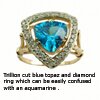 The closest competitor to this gem is the treated blue topaz, which is much lower in terms of price. Since the color of aquamarine is unique, only close inspection is required to differentiate it from its simulants. Other common simulants are synthetic and natural blue spinel,, zircon, sapphire, tourmaline and glass.
The closest competitor to this gem is the treated blue topaz, which is much lower in terms of price. Since the color of aquamarine is unique, only close inspection is required to differentiate it from its simulants. Other common simulants are synthetic and natural blue spinel,, zircon, sapphire, tourmaline and glass.
Aquamarine gemstone is the official state gem of Colorado, USA. It is worn by people born in the month of March and hence called as the March Birthstone.
1) Webster
2) Gemmology by Peter G.Read
3) Handbook of Gem Identification - Richard T.Liddicoat, jr
4) Gems and Crystals - From the American Museum of Natural History - Anna S.Sofianides and George E.Harlow.
Home | Add URL | About Us | Contact Us | Links | Privacy Policy | Resources | Sitemap | Design by Paper Tree
Copyright 2007 GehnaBazaar.com. All rights reserved. The information contained in this webpage may not be published, broadcast, rewritten or redistributed without a prior written consent. Natural Gemstones | Precious Gemstones | Jewellery Designers | Jewelry Institutes | Jewelery Design Institutes | Gemstone Information | Diamond Information | Gemmological Laboratories | Gem Labs | Jewelry Articles | Gold Price | Jewel Store | Buy and Sell Jewellery | Jewery Classes | Deisgn classes | Gemologists | Diamond Price